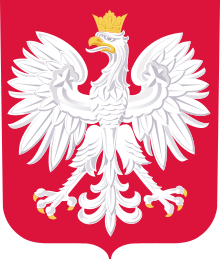Polish Armed Forces
| Armed Forces of the Republic of Poland Siły Zbrojne Rzeczypospolitej Polskiej | |
|---|---|
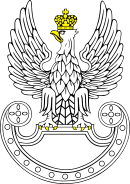   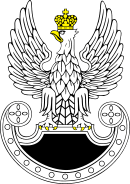 | |
| Service branches |
Polish Land Forces Polish Air Force Polish Navy Polish Special Forces |
| Leadership | |
| Supreme Commander | President Andrzej Duda |
| Minister of Defense | Antoni Macierewicz |
| Chief of Staff | Mieczysław Gocuł |
| Manpower | |
| Military age | 18 years of age |
| Conscription | No (since 2009) |
| Available for military service | 18,830,448, age 15–49 (2010 est.) |
| Fit for military service | 15,583,917, age 15–49 (2010 est.) |
| Reaching military age annually | 433,061 (2010 est.) |
| Active personnel | 101,500 (2016)[1] (ranked 42nd) |
| Reserve personnel | 22,850 (National Reserve Forces and cadets)[1] |
| Expenditures | |
| Budget | $9.4 billion (FY2016)[2] rank |
| Percent of GDP | 2% (FY2016) |
| Industry | |
| Domestic suppliers |
Polish Defence Holding WZM S.A. PZL-Świdnik HSW S.A. OBRUM |
| Foreign suppliers |
Former: |
| Annual exports |
|
| Related articles | |
| History |
List of Polish wars Timeline of the Polish Army |
| Ranks | Polish Armed Forces rank insignia |
Armed Forces of the Republic of Poland (Siły Zbrojne Rzeczypospolitej Polskiej, abbreviated SZ RP; popularly, Wojsko Polskie, abbreviated WP—roughly, the "Polish Military") are the national armed forces of Poland. The name has been used since the early nineteenth century, but can also be applied to earlier periods.
The Armed Forces of the Republic of Poland are the Wojska Lądowe (Land Forces), Marynarka Wojenna (Navy), Siły Powietrzne (Air Force) and Wojska Specjalne (Special Forces) and are under the command of the Ministerstwo Obrony Narodowej (Ministry of National Defense).
From 2002 until 2014, Polish military forces were part of the Coalition Forces that participated in the ISAF mission in Afghanistan led by NATO. Poland's contribution to ISAF was the country's largest, since its entrance into NATO.
Polish forces also took part in the Iraq War. From 2003 to 2008, Polish military forces commanded the Multinational Division (MND-CS) located in the South-Central Zone of Iraq. This zone was populated by about 5 million Iraqis, and covered an area of over 65,632 km². The division was made up of troops from 23 nations and totaled as many as 8,500 soldiers.
Mission
Pursuant to the national security strategy of the Republic of Poland, the supreme strategic goal of Poland's military forces is to ensure favourable and secure conditions for the realization of national interests by eliminating external and internal threats, reducing risks, rightly assessing undertaken challenges, and ably using existing opportunities.[3] The Republic of Poland’s main strategic goals in the area of defence include:
- ensuring the independence and sovereignty of the Republic of Poland, as well as its integrality and the inviolability of its borders;
- defence and protection of all the citizens of the Republic of Poland;
- creating conditions to ensure the continuity of the implementation of functions by public administration authorities and other entities competent in the area of national security, including entities responsible for running the economy and for other areas important for the life and security of its citizens;
- creating conditions for the improvement of the state’s national defence capabilities and ensuring defence readiness in allied structures;
- developing partnership military cooperation with other states, especially neighbouring ones;
- implementing commitments arising from Poland’s NATO and European Union membership;
- engaging in international crisis response operations led by NATO, the EU, the UN, and as a part of emergency coalitions.
History
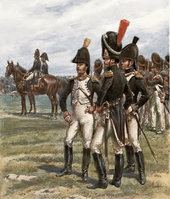
The List of Polish wars chronicles Polish military involvements since the year 972. The present armed forces trace their roots to the early twentieth century, yet the history of Polish armed forces in their broadest sense stretches back much further. After the partitions of Poland, during the period from 1795 until 1918, Polish military was recreated several times during national insurrections that included the November Uprising of 1830, and the January Uprising in 1863, and the Napoleonic Wars that saw the formation of the Polish Legions in Italy. The Kingdom of Poland, ruled by the Russian Tsar with a certain degree of autonomy, had a separate Polish army in the years 1815–1830 which was disbanded after the unsuccessful insurrection. Large numbers of Poles also served in the armies of the partitioning powers, Russia, Austria-Hungary (before 1867 Austria) and Germany (before 1871 Prussia). However, these powers took care to spread Polish soldiers all over their armies and as a rule did not form predominantly Polish units.
During World War I, the Polish Legions were set up in Galicia, the southern part of Poland under Austrian occupation. They were both disbanded after the Central Powers failed to provide guarantees of Polish independence after the war. General Józef Haller, the commander of the Second Brigade of the Polish Legion, switched sides in late 1917, and via Murmansk took part of his troops to France, where he created the Blue Army. It was joined by several thousand Polish volunteers from the United States. It fought valiantly on the French front in 1917 and 1918.
The Polish Army was recreated in 1918 from elements of the three separate Russian, Austro-Hungarian, and Prussian armies, and armed with equipment left following World War I. The force expanded during the Polish–Soviet War of 1919–1922 to nearly 800,000 men, but then was reduced when peace was reestablished.
Second World War
During the Second World War, on 1 September 1939 the force was nearly one million men strong, but was overwhelmed by the German attack in September 1939, which was followed on 17 September 1939 by an invasion by the Soviet Union. Some Polish forces escaped from their occupied, divided country, and joined Allied forces fighting in other theatres while those that remained in Poland splintered into guerilla units of the Armia Krajowa ("Home Army") and other partisan groups which fought in clandestine ways against the foreign occupiers of Poland. Thus there were three threads to Polish armed forces from 1939; the Polish Armed Forces in the West, the Armia Krajowa and other resistance organisations fighting the Germans in Poland, and the Polish Armed Forces in the East, which later became the post-war communist Polish People's Army (LWP).
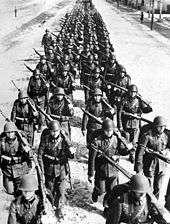
The Polish Armed Forces in the West comprised army, navy, and air force units, and were loyal to the Polish government-in-exile. Army formations and units included the Polish Army in France (1939–1940), the Polish I Corps in the West, the Polish II Corps, and the rump Command in the Middle East that was briefly designated the III Corps.[4] Amongst their most notable operations were the actions of the 1st Armoured Division at Mont Ormel, during the Normandy campaign, the Battle of Monte Cassino (Operation Diadem) scaling of the mountain by elements of II Polish Corps, and actions during the Battle of Arnhem by the 1st Polish Parachute Brigade.[5] The Polish Air Forces in France and Great Britain numbered fifteen squadrons under Royal Air Force and Army Air Corps operational control, as well as units under the direction of the French Air Force. The Polish Air Force fought in the Battle of France as one fighter squadron (GC 1/145), several small units detached to French squadrons, and numerous industry defence flights (approximately 130 pilots, who achieved 55 victories at a loss of 15 men).[6] Naval units comprised three destroyers of the Polish Navy that had escaped from Poland under the Peking Plan to fight alongside the Western allies from Britain, as well as many other vessels that later came to be manned by Polish crews under Royal Navy auspices. These vessels included the cruisers ORP Dragon and Conrad, seven destroyers, three Type II Hunt class destroyers, and five submarines.
.jpg)
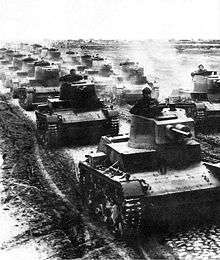
What later became the communist LWP was formed during the Second World War as the Polish 1st Tadeusz Kościuszko Infantry Division, also unofficially known as the Berling Army. The majority of officers were Polish. The first Polish force formed in the USSR, the Anders Army, had by that time moved to Iran. Polish forces soon grew beyond the 1st Division into two major commands—the First Polish Army (Berling's) and the Polish Second Army (commanded by Karol Świerczewski). The Polish First Army participated in the Vistula–Oder Offensive and the Battle of Kolberg (1945) before participating in its final offensive with the Battle of Berlin. The Polish Second Army served under command of the Soviet 1st Ukrainian Front in 1945 and fought in the vicinity of Bautzen and Dresden. In the east these two armies were supported at times by Polish air units, part of the Air Force of the Polish Army.
The communist-aligned Polish military formation was the People's Army of Poland, formed in the Soviet Union and partially integrated with Red Army formations. It became the core of the armed forces of post-war Poland. It was known officially as the Armed Forces of the Republic of Poland from 1945 to 1952 (the same as the current name), and Armed Forces of People's Republic of Poland from 1952 to 1990, reflecting the country's name change from Republic of Poland to People's Republic of Poland.
After 1945
.jpg)
The first postwar Minister of National Defence was Marszałek Polski Michał Rola-Żymierski, promoted by Stalin's order to the rank of Marshal of Poland on 3 May 1945. However, Michta writes that while the 'army was formally under Zymierski's command until 1949, it was ultimately controlled by two Soviet officers, Generals Korczyc and Poplawski.'[7] From 1949 to 1956 the Polish armed forces were under the command of Zymierski's successor as Minister of National Defense, Marshal of the Soviet Union Konstantin Rokossovsky, who was given the additional title Marshal of Poland. Rokossovsky was succeeded by Marian Spychalski, who was released from prison to take the post. The People's Army of Poland was prepared to defend the country against a possible new invasion from the West (based on the plan by Stefan Mossor). It was increasingly tied into the Soviet structures. This process was however stopped in the aftermath of the Polish October in 1956, however, and brigades and regiments began to be formed in the engineering, artillery and communications arms.
1954 would see the Air Force and the Air Defense Forces merged into the Polish Air and National Air Defense Forces, a process that would last till 1962 (this would happen again in 1990).
After the war the Polish Army was reorganized into six (later seven) military districts. These were the Warsaw Military District, headquarters (HQ) in Warsaw, the Lublin Military District, HQ in Lublin, the Kraków Military District, HQ in Kraków, the Łódź Military District, HQ in Lodz, the Poznań Military District, HQ in Poznan, the Pomeranian Military District, HQ in Torun, and the Silesian Military District, HQ in Katowice, created in autumn 1945. They were later reduced to four, then three and later into the two military districts active as of 2011.
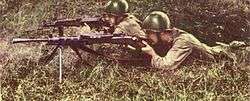

Until the fall of communism the army's prestige continued to fall, as it was used by the communist government to resettle ethnicities immediately after the war (Operation Vistula), and to violently suppress opposition several times, during the Poznań 1956 protests, the Polish 1970 protests, and during Martial law in Poland in 1981–1982. The LWP also took part in the suppressing of the 1968 democratization process of Czechoslovakia, commonly known as the Prague Spring. That same year Marshal of Poland Marian Spychalski was asked to replace Edward Ochab as chairman of the Council of State, and General Wojciech Jaruzelski, at that time the Chief of the General Staff, was named to replace him.[8] Michta argues that Jaruzelski, as a known Soviet loyalist, reflected the Soviet decision to 'put a trusted group of officers in control of one of the least trusted armies in the Warsaw Pact forces.'[9] The command post for the 1968 Warsaw Pact invasion of Czechoslovakia was actually located on Polish soil, at Marshal Ivan Yakubovsky's Legnica headquarters.[10]
In 1953 Poland began to make contributions to peacekeeping operations, initially the Neutral Nations Supervisory Commission on the North Korean/South Korean border, where it maintained personnel until 1995.[11] From 1953–1973 Poland military and civilian personnel also took part in the International Commission for Supervision and Control in Indochina and the International Group of Observers in Nigeria.[12] Poland has maintained for decades a long-standing commitment to the United Nations Interim Force in Lebanon (500 personnel). The Polish Armed Forces took part in the United Nations-sanctioned coalition during the Gulf War in 1991, deploying two ships, the Piast and Wodnik, and a medical team (see pl:PKW Zatoka Perska (1991)). In 1994–95 53 GROM special forces personnel were despatched to Haiti for Operation Uphold Democracy.
After January 1990 the name of the armed forces was changed to 'Armed Forces of the Republic of Poland,' to accord with the Polish State's new official name.
In March 2003 the Polish Armed Forces took part in the 2003 invasion of Iraq, deploying special forces and a support ship.[13] Following the destruction of Saddam's regime the Polish Land Forces supplied a brigade and a division headquarters for the 17-nation Multinational Division Central-South, part of the U.S.-led Multi-National Force Iraq. At its peak Poland had 2,500 soldiers in the south of the country. Other completed operations include 2005 'Swift Relief' in Pakistan, in which NATO Response Force-allocated personnel were despatched. Polish Land Forces personnel sent to Pakistan included a Military Engineers company, a platoon of the 1st Special Commando Regiment, and a logistics component from the 10th Logistics Brigade. Elsewhere, Polish forces were sent to MINURCAT in Chad and the Central African Republic (2007–2010). As of 2008, Poland had deployed 985 personnel in eight separarate UN peacekeeping operations (the United Nations Disengagement Observer Force, MINURSO, MONUC, UNOCI, UNIFIL, UNMEE, UNMIK, UNMIL, and UNOMIG).[14]
A new joint operational headquarters, the Dowodztwo Operacyjne (DO) was planned to declare its initial operating capability on 1 January 2005, and full operational capability on 1 July 2005.[15] The DO was created on 22 October 2003, with the first officers being assigned in the second quarter of 2004. Most of the headquarters' 110 military staff were planned to be transferred from the 1st Mechanised Corps headquartered at Bydgoszcz, which was disbanded in 2004.
.jpg)
Formerly organised according to Warsaw Pact standards, the armed forces are currently being reorganised according to NATO standards. 'Eagle Guardian' is apparently the NATO planning designation for contingency plans to deploy and defend Poland and the Baltic States.[16] Poland is also playing an increasingly larger role as a major European peacekeeping power in the world through various UN peacekeeping actions, and cooperation with neighbouring nations through multinational formations and units such as the Multinational Corps Northeast and POLUKRBAT. As of 1 January 2010, the Armed Forces of the Republic of Poland have transitioned to a completely contract-based manpower supply system.
On 10 April 2010 a Polish Air Force Tu-154M crashed near Smolensk, Russia while in transit to a ceremony commemorating the Katyn massacre. On board the plane were the President (Commander-in-Chief), the Chief of Staff, all four Branch Commanders of the Polish Military, and a number of other military officials; all were killed. However, the Minister of Defense stayed in Warsaw, avoiding the crash in the process.
Organization
.jpg)

The Polish Armed Forces consist of 100,000[17] active duty and 50,000 active reserve personnel. In 2014, troop strength in the four different branches was as follows:
- Land Forces: 77,000 military[18]
- Air Force: 36,500 military[18]
- Navy: 12,600 military[19] ~94 vessels [20]
- Special Forces: 2,500[21]
All four branches are supported by:
- Military infrastructure: 30,000[19] (Representing 39,8% of the entire active duty personnel), it includes:
- Military Gendarmerie 4,500[21]
- Military reserve forces: 20,000 (Part-time volunteers which serve within the Land Forces, Navy and Air Force)[22]
In addition, Polish Armed Forces employ around 70,000 civilians who are split through all branches of the military.[23] In 2010, the Ministry of National Defence of the Republic of Poland announced its intention about reducing its number by around 10% until 2012[24] In 2015, it was announced by the government that a greater allocation of financial resources will be allocated to the armed forces in order to build up Poland's military potential.
Besides the regular armed forces there are also various independent paramilitary groups, estimated to comprise about 80,000 people in total.[25] The Polish government has decided that starting in September 2016 about 35,000 paramilitaries will be recruited into closer cooperation with the regular armed forces through the Territorial Defence Force.[26]
Equipment
As of 2011, the Armed Forces are in the middle of a long-term modernisation programme. Immediate plans involve new anti-aircraft missile systems, ballistic missile defence systems, a Lead-In Fighter Trainer (LIFT) aircraft, medium transport and combat helicopters, submarines, unmanned aerial vehicles, as well as self-propelled howitzers.
Land Forces
- Main battle tanks: 1,010 (Leopard 2A4, Leopard 2A5, PT-91, PT-91MA1, T-72, T-72A, T-72M1, T-72M1D), PL-01[27]
- AFV: 3,110 (KTO Rosomak, BWP-1, BWR-1S, BWR-1D, HMMWV, BRDM-2)[27]
- Artillery: 1,000 (120 mm (5 in) or greater).[27]
- Army Helicopters: 250 (PZL W-3, Mi-8, Mi-17, Mi-24, Mi-2 )[27]
Air Force
- Jet Fighter: 112 (32 MiG-29A/UB, 48 F-16 C/D Block 52+, 32 Su-22M-4K/UM3K )[27]
- Jet Trainer Aircraft: 54 (PZL TS-11 Iskra, + 8 M-346 from 2016)[27]
- Turboprop Trainer Aircraft: 37 (PZL-130 Orlik)[27]
- Cargo aircraft: 41 (C-295M, C-130, PZL M28)[27]
- Helicopters: 53 (PZL W-3, PZL SW-4, Mi-8, Mi-2)[27]
Navy
- Frigates: 2 (Oliver Hazard Perry Class)[27]
- Corvettes: 1 (Kaszub class)[27]
- Submarines: 5 (Kilo Class, Kobben Class)[27]
- Fast Attack Craft: 3 (Orkan class)[27]
- Mine Counter-Measure Vessels: 19 (Gardno class, Mamry class, 206FM class)[27]
- Minelayer-Landing crafts: 5 (Lublin class)[27]
- Over 40 other vessels (including survey ships, tankers, rescue and salvage and training ships)[27]
- Aircraft: 12 (PZL M28B Bryza)[27]
- Helicopter: 30 (Kaman SH-2, PZL W-3, Mil Mi-14, PZL Mi-2, Mil Mi-17)[27][28]
-
.jpg)
Leopard 2A5, main battle tank
-

KTO Rosomak, armoured fighting vehicle
-

152mm SpGH DANA, self-propelled artillery
-
_F-16C_Block_52_(6_ELT).jpg)
F-16D block 52, multirole fighter aircraft
-
.jpg)
MiG-29, fighter aircraft
-

Frigate ORP Gen. K. Pułaski
Personnel
The Polish Armed Forces are the only military entity in the world to use a two-finger salute which is only used while wearing a hat (it refers to the fact that the salute is given to the emblem itself) with the emblem of the Polish eagle, such as military hat rogatywka. The salute is performed with the middle and index fingers extended and touching each other, while the ring and little fingers are bent and touched by the thumb. The tips of the middle and index fingers touch the peak of the cap, two fingers supposedly meaning honour and fatherland (Honor i Ojczyzna).
Notes
| Wikimedia Commons has media related to Military of Poland. |
- 1 2
- ↑ , Budżet i plany inwestycyjne MON w roku 2016 .
- ↑ Ministry of National Defence, Defence Strategy of the Republic of Poland, Warsaw, 2009. Strategic defence goals, p.7-8.
- ↑ see pl:III Korpus Polski (PSZ)
- ↑ "Chapter 5. The Polish contribution to the liberation of the Netherlands (1944-1945)". Polish forces in the West. Retrieved 2016-01-10.
- ↑ (Polish) Wojsko Polskie we Francji. Świat Polonii. Sources give estimates that can differ by few percent.
- ↑ Andrew A. Michta, Red Eagle: The Army in Polish Politics 1944–1988, Hoover Press, 1990, p.44. Source see footnote 19, p.44
- ↑ Michta, 1990, p.59, citing the Polish army daily Żołnierz Wolności, April 12, 1968
- ↑ Michta, 1990, p.62. Michta's footnote emphasises that Spychalski would not have been the right officer to have in charge of the Armed Forces of the People's Republic of Poland during the invasion.
- ↑ Michta, 1990, p.62. Michta's footnote cites 'Testimony of traitor Col. Ryszard Kuklinski, who participated in the preparation of the invasion plans.' See Kuklinski p.10
- ↑ "Polish observers leave North Korea via Beijing". AP. 9 March 1995. Retrieved 3 June 2016.
- ↑ Ministry of National Defence, Missions, accessed November 2011
- ↑ Around 200 Polish soldiers took part in combat, including GROM and Formoza (Naval Frogmen Group) special forces, a chemical decontamination unit as well as the ORP Kontradmirał X. Czernicki logistical ship. (Rafał Domisiewicz, Consolidating the Security Sector in Post-Conflict States: Polish Lessons from Iraq, Austrian Ministry of Foreign Affairs)
- ↑ SWiSH v2.0. "Wojskowe misje ONZ z udziałem Polaków" (in Polish). Skmponz.w.interia.pl. Retrieved 2011-11-20.
- ↑ Grzegorz Holdanowicz, 'Polish Joint HQ becomes operational,' Jane's Defence Weekly, 22 December 2004, p.5
- ↑ The Guardian,
- ↑ Polish Military personnel
- 1 2 http://mon.gov.pl/z/pliki/dokumenty/rozne/2014/04/podstawowe_informacje_o_budzecie_resortu_ON_na_2014_r.pdf
- 1 2 http://www.bip.mon.gov.pl/pliki/file/wersja%20polska.ppt
- ↑ ":: Ministerstwo Obrony Narodowej - serwis internetowy :: Uzbrojenie ::". Mon.gov.pl. 2012-03-21. Retrieved 2012-04-17.
- 1 2 http://www.dz.urz.mon.gov.pl/zasoby/dziennik/pozycje/zalaczniki/2013/02/Zal._do_Poz._49_2.pdf
- ↑ Onet.pl, Rewolucja w polskiej armii- Wiadomości, 21.03.2009
- ↑ "Klich: dla cywilnych pracowników wojska podwyżka 180 zł brutto - Praca i ubezpieczenia - Gazeta Prawna - Partner pracodawcy, narzędzie specjalisty". Praca.gazetaprawna.pl. Retrieved 2011-11-20.
- ↑ "Tysiące pracowników wojska pójdą na bruk | Gorący Temat". Blog.rp.pl. 2010-06-16. Retrieved 2011-11-20.
- ↑ "Inside Poland's Independent Paramilitary Groups". Vice News. 2015.
- ↑ "Poland To Recruit 35,000 For Paramilitary Force To Counter Russia". Radio Free Europe/Radio Liberty. June 3, 2016.
- 1 2 3 4 5 6 7 8 9 10 11 12 13 14 15 16 17 18 Ministry of National Defence. ":: Ministerstwo Obrony Narodowej - serwis internetowy :: Uzbrojenie ::".
- ↑ "BLMW" (in Polish). BLMW. Retrieved 2011-11-20.
References
- Rafał Domisiewicz, Consolidating the Security Sector in Post-Conflict States: Polish Lessons from Iraq, Austrian Ministry of Foreign Affairs
- Andrew A. Michta, 'Red Eagle: The Army in Polish Politics 1944–1988, Hoover Press, 1990
- Ministry of National Defence, Defence Strategy of the Republic of Poland, Warsaw, 2009.
Further reading
- Remigiusz Wilk, "Work in Progress", Jane's Defence Weekly, 20 August 2012, and Jane's Interview, same issue
External links
- Official website of the Ministerstwo Obrony Narodowej
- Official website of the Sztab Generalny Wojska Polskiego
- Official website of the Dowództwo Operacyjne Sił Zbrojnych
- Official website of the Żandarmeria Wojskowa
- kamouflage.net, Republic of Poland
- Pictures from Iraq of Polish Army
- All change as Poland boosts military spending via http://www.worldreview.info
- Polish forces in the West (historical account of Polish operations in Western Europe)
